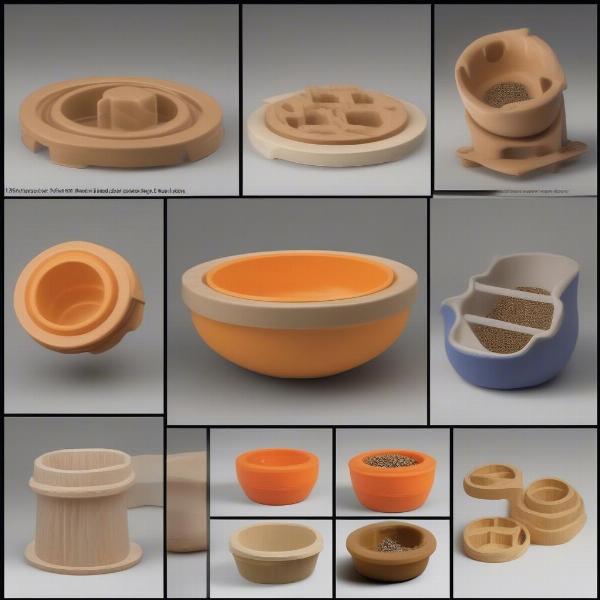Slow feeders are a popular solution for dogs who gobble their food down too quickly. This habit can lead to a variety of problems, including choking, vomiting, and bloat. Slow feeders can help your dog eat at a healthier pace, improving their digestion and overall well-being. This comprehensive guide will explore the benefits, types, and selection process for slow feeders, helping you make the best choice for your furry friend.
Why Use a Slow Feeder?
Rapid eating in dogs, often referred to as “bolting,” can cause several health issues. By slowing down mealtime, a slow feeder can prevent choking hazards, reduce the risk of vomiting, and minimize the chances of bloat, a life-threatening condition. Additionally, slow feeders can make mealtime more engaging and mentally stimulating for your dog.
Types of Slow Feeders
There are various types of slow feeders available, each designed with unique features to cater to different dog breeds, sizes, and eating habits. Some popular options include:
- Bowl-shaped slow feeders: These are typically bowls with raised sections or obstacles that force the dog to maneuver their food around.
- Mat-style slow feeders: These are flat mats with various textures and patterns designed to slow down eating. They are particularly good for dogs who like to lick their food.
- Puzzle feeders: These offer a higher level of mental stimulation, requiring dogs to solve puzzles to access their food.
 Different types of slow feeder bowls
Different types of slow feeder bowls
Choosing the Right Slow Feeder for Your Dog
Selecting the right slow feeder depends on several factors, including your dog’s breed, size, eating habits, and any existing health conditions. Consider the following:
- Size and breed: Ensure the feeder is appropriately sized for your dog. A small feeder for a large dog will be ineffective, while a large feeder for a small dog may be overwhelming.
- Material: Choose a durable and non-toxic material. Stainless steel and food-grade silicone are good options.
- Design: The design should effectively slow down eating without causing frustration. Observe your dog’s eating style to determine which design will be most beneficial.
- Ease of cleaning: Opt for a slow feeder that is easy to clean and dishwasher-safe if possible.
Does My Dog Need a Slow Feeder?
If your dog exhibits signs of gulping, choking, or vomiting after meals, a slow feeder is highly recommended. Even if your dog doesn’t show these signs, a slow feeder can be a preventative measure to promote healthier eating habits.
What are the benefits of using a slow feeder bowl for dogs?
Slow feeder bowls prevent gulping, reduce bloat risk, and make mealtime more engaging for your dog.
How do I choose the right slow feeder for my dog?
Consider your dog’s size, breed, and eating habits. slow feeder bowl for dogs provide various options.
Are slow feeders good for all dogs?
While most dogs benefit, some may get frustrated. dog bowl slow feeder offer advice on choosing the right one.
Can slow feeders help with weight management?
Yes, by prolonging mealtime and increasing satiety, slow feeder dogs can contribute to weight management.
Where can I find high-quality slow feeders?
dog kennel feeders offer a range of options for different needs.
Conclusion
Slow feeders are a valuable tool for promoting healthy eating habits in dogs. By slowing down mealtime, they can prevent a range of digestive problems and enhance your dog’s overall well-being. Choosing the right slow feeder involves considering your dog’s individual needs and preferences. With careful selection, you can provide your dog with a safer and more enjoyable mealtime experience.
1. What if my dog refuses to eat from a slow feeder?
Try introducing the slow feeder gradually, mixing a small amount of food in it with their regular bowl. You can also try different types of slow feeders to find one that your dog prefers.
2. Are slow feeders safe for puppies?
Yes, slow feeders can be beneficial for puppies to establish healthy eating habits from a young age.
3. How do I clean a slow feeder?
Most slow feeders are dishwasher-safe, but always check the manufacturer’s instructions. Hand washing with warm soapy water is also effective.
Expert Insight:
- Dr. Emily Carter, DVM: “Slow feeders are a simple yet effective way to improve a dog’s digestive health. They can significantly reduce the risk of bloat, a serious condition that can be fatal.”
- Sarah Miller, Certified Dog Trainer: “Slow feeders can also provide mental enrichment for dogs, turning mealtime into a more engaging activity.”
ILM Dog is your trusted resource for expert advice on dog care, training, and well-being. We offer a wide range of information and resources to help you provide the best possible care for your canine companion. From breed selection to health and nutrition, ILM Dog is dedicated to providing accurate and up-to-date information for dog owners worldwide. Contact us today for expert advice and guidance: Email: [email protected], Phone: +44 20-3965-8624.